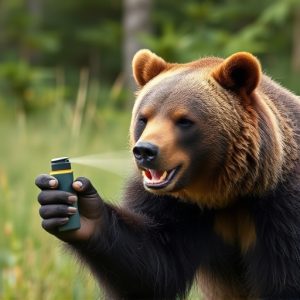Bear Defense Spray: Effectiveness, Science, and Safe Camping Practices
Bears pose significant risks to campers, but understanding their reaction to strong odors, like bear…….
Bears pose significant risks to campers, but understanding their reaction to strong odors, like bear spray's scent, can enhance safety. Bear spray, primarily containing capsaicin, disrupts a bear's sensory perception and creates an irritating barrier. Its effectiveness depends on distance, wind, and application technique. Research indicates it can deter black and grizzlies under optimal conditions, but its success rate varies. To ensure safety in bear country, campers should follow usage instructions, stay informed about the latest research, and maintain calmness during encounters. Bear spray is a crucial last-resort measure when bears show aggression or are within 20-30 feet.
“Enhancing your camping experience while navigating potential bear encounters involves understanding their behavior and arming yourself with the right tools—bear defense spray. This article delves into the science behind this powerful tool, exploring its active ingredients and efficacy through research. We’ll guide you on best practices for carrying and using bear spray, ensuring a safe and enjoyable outdoor adventure. Discover how effective bear spray can be in preventing aggressive interactions.”
- Understanding Bear Behavior and Their Reaction to Spray
- The Science Behind Bear Defense Spray: Active Ingredients and Efficacy Studies
- Best Practices for Carrying and Using Bear Spray While Camping
Understanding Bear Behavior and Their Reaction to Spray
Bears, despite their seemingly docile nature, are wild animals with complex behaviors that campers should understand to ensure safety in bear country. When it comes to defense sprays, knowing how bears react is crucial. Research has shown that black bears and grizzly bears have a natural aversion to strong odors, which is why bear spray is an effective deterrent. When used correctly, bear spray can create a buffer zone, providing campers with precious time to retreat or stay calm in the face of an encounter.
The effectiveness of bear spray lies in its ability to disrupt a bear’s sensory perception. The highly concentrated pepper spray creates an irritating mist that bears typically avoid. Studies have demonstrated that even a brief moment of distraction can be life-saving, allowing individuals to escape or find safety behind barriers or within secure shelters. However, it’s important to note that the success rate varies based on factors like bear distance, wind direction, and individual sprayer technique.
The Science Behind Bear Defense Spray: Active Ingredients and Efficacy Studies
Bear defense spray, also known as bear spray, is a popular camping supply designed to deter and repel bears in case of encounters. The science behind its effectiveness lies in understanding its active ingredients and the research supporting its efficacy. Bear spray typically contains capsaicin, a compound found in chili peppers, which is the key ingredient responsible for its irritating properties. When sprayed directly into a bear’s face, capsaicin disrupts their sensory perception, temporarily blinding and disorienting them, allowing campers to escape or seek safety.
How effective is bear spray according to research? Numerous studies have evaluated the performance of bear defense spray under various conditions. Tests have shown that when used correctly, bear spray can successfully deter both black bears and grizzly bears. The spray creates a barrier by causing the bear’s eyes to water and its respiratory system to irritate, leading to a temporary retreat. However, factors like distance, weather conditions, and the bear’s temperament can impact the spray’s effectiveness. As such, it’s crucial to follow usage instructions carefully and be aware of the latest research findings for optimal protection while camping in bear country.
Best Practices for Carrying and Using Bear Spray While Camping
Carrying and using bear spray while camping is a crucial part of ensuring your safety in bear country. Always keep it within easy reach, like on a belt or in a backpack’s exterior pocket, so it’s readily available if needed. Familiarize yourself with its operation before heading out; practice spraying at close range to ensure you understand the range and effectiveness.
When encountering a bear, remain calm and assess the situation. If the bear hasn’t noticed you, make yourself seen and heard by shouting loudly and making loud noises. Back away slowly if the bear does notice you, giving it an escape route. Only use bear spray as a last resort when the bear displays aggressive behavior or is within spraying distance (typically 20-30 feet). Aim for the bear’s face and eyes, spraying in short bursts to create a barrier of fog between you and the animal.
Bear defense spray has proven to be an effective tool in protecting campers from bear encounters, as supported by numerous research studies. Understanding bear behavior and proper usage techniques are key to ensuring its efficacy. By following best practices and staying informed about the latest research, campers can maximize their safety while enjoying the outdoors. Bear spray remains a valuable addition to any camping supply kit.


